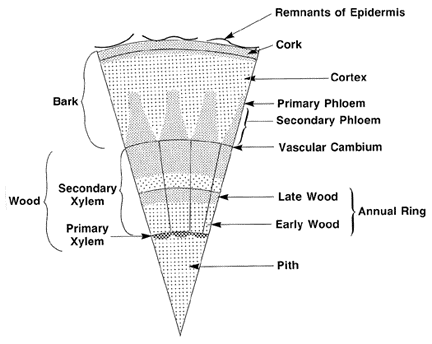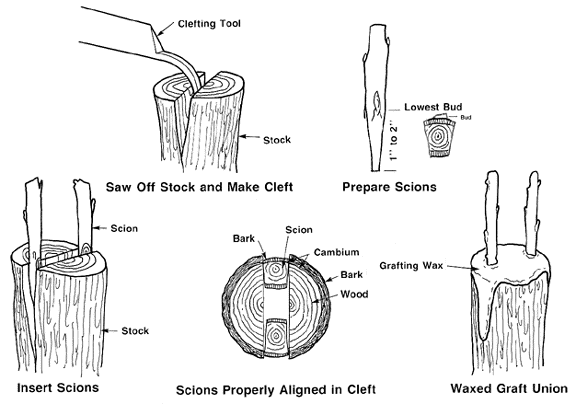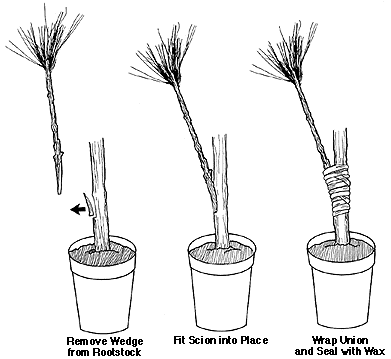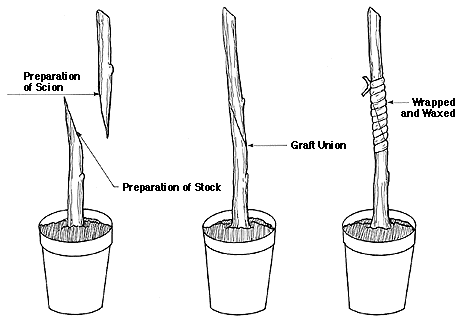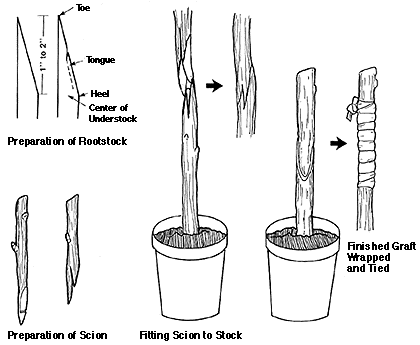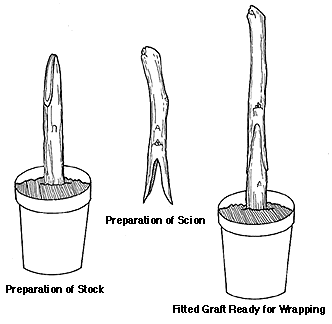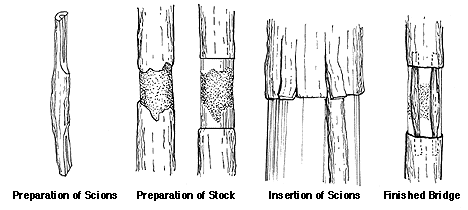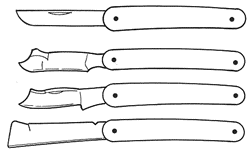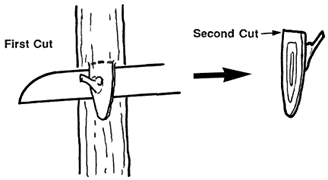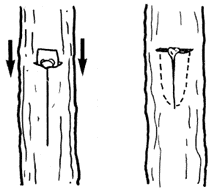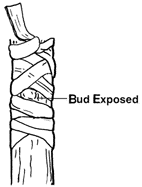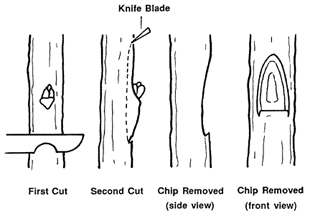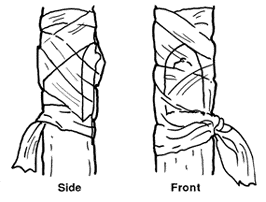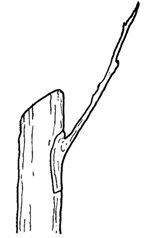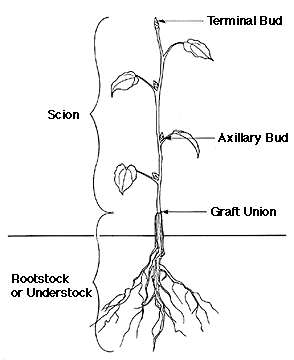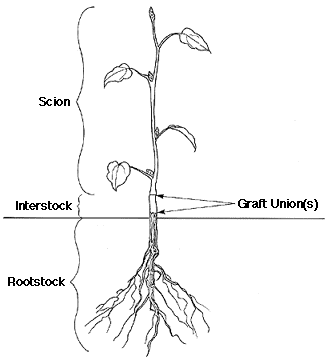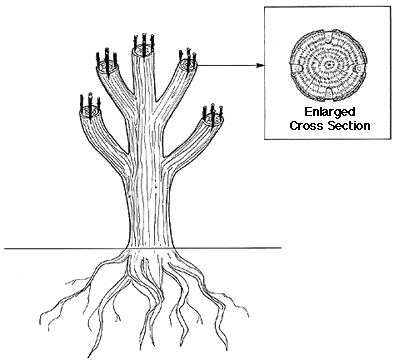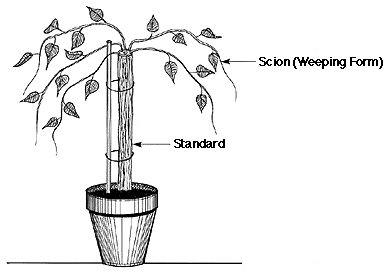Introduction
Grafting and budding are horticultural techniques used to join parts from two or more plants so that they appear to grow as a single plant. In grafting, the upper part (scion) of one plant grows on the root system (rootstock) of another plant. In the budding process, a bud is taken from one plant and grown on another.
Although budding is considered a modern art and science, grafting is not new. The practice of grafting can be traced back 4,000 years to ancient China and Mesopotamia. As early as 2,000 years ago, people recognized the incompatibility problems that may occur when grafting olives and other fruiting trees.
Since grafting and budding are asexual or vegetative methods of propagation, the new plant that grows from the scion or bud will be exactly like the plant it came from. These methods of plant reproduction are usually chosen because cuttings from the desired plant root poorly (or not at all). Also, these methods give the plant a certain characteristic of the rootstock - for example, hardiness, drought tolerance, or disease resistance. Since both methods require extensive knowledge of nursery crop species and their compatibility, grafting and budding are two techniques that are usually practiced only by more experienced nursery operators.
Most woody nursery plants can be grafted or budded, but both processes are labor intensive and require a great deal of skill. For these reasons they can be expensive and come with no guarantee of success. The nurseryman must therefore see in them a marked advantage over more convenient propagation techniques to justify the time and cost.
Clones or varieties within a species can usually be grafted or budded interchangeably. For example, Pink Sachet dogwood can be budded or grafted onto White Flowering dogwood rootstock and vice versa. Bradford pear can be grafted or budded onto Callery pear rootstock and vice versa. However, Pink Sachet dogwood cannot be grafted or budded onto Callery pear.
Grafting and budding can be performed only at very specific times when weather conditions and the physiological stage of plant growth are both optimum. The timing depends on the species and the technique used. For example, conditions are usually satisfactory in June for budding peaches, but August and early September are the best months to bud dogwoods. Conversely, flowering pears can be grafted while they are dormant (in December and January) or budded during July and August.
Reasons for Grafting and Budding
Budding and grafting may increase the productivity of certain horticultural crops because they make it possible to do the following things:
- Change varieties or cultivars. An older established orchard of fruiting trees may become obsolete as newer varieties or cultivars are developed. The newer varieties may offer improved insect or disease resistance, better drought tolerance, or higher yields. As long as the scion is compatible with the rootstock, the older orchard may be top worked using the improved variety or cultivar.
- Optimize cross-pollination and pollination. Certain fruit trees are not self-pollinating; they require pollination by a second fruit tree, usually of another variety. This process is known as cross-pollination. Portions of a tree or entire trees may be pollinated with the second variety to ensure fruit set. For example, some hollies are dioecious, meaning that a given plant has either male or female flowers but not both. To ensure good fruit set on the female (pistillate) plant, a male (staminate) plant must be growing nearby. Where this is not possible, the chances that cross-pollination will occur can be increased by grafting a scion from a male plant onto the female plant.
- Take advantage of particular rootstocks. Compared to the selected scion, certain rootstocks have superior growth habits, disease and insect resistance, and drought tolerance. For example, when used as rootstock for commercial apple varieties, the French crabapple (Malus sylvestris, Mill.) can increase resistance to crown gall and hairy root. Malling VIII and Malling IX are used as dwarfing rootstocks for apple trees when full-sized trees are not desired, such as in the home garden.
- Benefit from interstocks. An interstock can be particularly valuable when the scion and rootstock are incompatible. In such cases, an interstock that is compatible with both rootstock and scion is used. An interstock could increase the disease resistance or cold hardiness of the scion. Plants also may be double worked to impart dwarfness or influence flowering and fruiting of a scion.
- Perpetuate clones. Clones of numerous species of conifers cannot be economically reproduced from vegetative cuttings because the percentage of cuttings that root successfully is low. Many can be grafted, however, onto seedling rootstocks. Colorado blue spruce (Picea pungens, Engelm), Koster blue spruce (Picea pungens var. Kosteriana, Henry), and Moerheim spruce (Picea pungens var. Moerheimii, Rujis) are commonly grafted onto Norway spruce (Picea abies, Karst.) or Sitka spruce (Picea sitchensis, Carr.) rootstock to perpetuate desirable clones. Numerous clones of Japanese maple (Acer palmatum, Thunb.) that either root poorly or lack an extensive root system are grafted onto seedling Acer palmatum rootstock.
- Produce certain plant forms. Numerous horticultural plants owe their beauty to the fact that they are grafted or budded onto a standard, especially those that have a weeping or cascading form. Examples include weeping hemlock (Tsuga canadensi.3, Carr. var. pendula, Beissn.), which is grafted onto seedling hemlock rootstock (Tsuga canadensis, Carr.); weeping flowering cherry (Prunus subhietella var. pendula, Tanaka), which is grafted onto Mazzard cherry rootstock (Prunus avium, L.); and weeping dogwood (Cornus florida, L. var. pendula, Dipp.), which is grafted onto flowering dogwood rootstock (Cornus florida, L.). In most cases, multiple scions are grafted or budded 3 feet or higher on the main stem of the rootstock. When used this way, the rootstock is referred to as a standard. It may require staking for several years until the standard is large enough to support the cascading or weeping top.
- Repair damaged plants. Large trees or specimen plants can be damaged easily at or slightly above the soil line. The damage may be caused by maintenance equipment (such as lawn mowers, trenchers, or construction equipment), or by disease, rodents, or winter storms. The damage can often be repaired by planting several seedlings of the same species around the injured tree and grafting them above the injury. This procedure is referred to as inarching, approach grafting, or bridge grafting.
- Increase the growth rate of seedlings. The seedling progeny of many fruit and nut breeding programs, if left to develop naturally, may require 8 to 12 years to become fruitful. However, if these progeny are grafted onto established plants, the time required for them to flower and fruit is reduced dramatically. Another way to increase the growth rate of seedlings is to graft more than one seedling onto a mature plant. Using this procedure as a breeding tool saves time, space, and money.
- Index viruses. Many plants carry viruses, although the symptoms may not always be obvious or even visible. The presence or absence of the virus in the suspect plant can be confirmed by grafting scions from the plant onto another plant that is highly susceptible and will display prominent symptoms.
Grafting
When to Graft
Unlike budding, which can be performed before or during the growing season, most grafting is done during winter and early spring while both scion and rootstock are still dormant. Containerized plants may be moved indoors during the actual grafting process; after grafting, these plants are placed in protected areas or in unheated overwintering houses. Field-grown stock, of course, must be grafted in place. Some deciduous trees are commonly grafted as bare rootstock during the winter and stored until spring planting. Indoor winter grafting is often referred to as bench grafting because it is accomplished at a bench.
Selecting and Handling Scion Wood
The best quality scion wood usually comes from shoots grown the previous season. Scions should be severed with sharp, clean shears or knives and placed immediately in moistened burlap or plastic bags. It is good practice during the harvesting of scions and the making of grafts to clean the cutting tools regularly. This may be done by flaming or immersing them in a sterilizing solution. Isopropyl (rubbing) alcohol also works well as a sterilant, although it evaporates quite readily. An alternative sterilizing solution may be prepared by mixing one part household bleach with nine parts water (by volume). However, this bleach solution can be highly corrosive to certain metals.
For best results, harvest only as much scion wood as can be used for grafting during the same day. Select only healthy scion wood that is free from insect, disease, or winter damage. Be sure the stock plants are of good quality, healthy, and true to type. Scion wood that is frozen at harvest often knits more slowly and in lower percentage. If large quantities of scion wood must be harvested at one time, follow these steps:
- Cut all scions to a uniform length, keep their basal ends together, and tie them in bundles of known quantity (for example, 50 scions per bundle).
- Label them, recording the cultivar, date of harvest, and location of the stock plant.
- Wrap the base of the bundles in moistened burlap or sphagnum, place them in polyethylene or waterproof paper bags, and seal the bags.
- Store the bundles for short periods, if necessary, either iced down in insulated coolers or in a commercial storage unit at 32° to 34°F.
- Never store scions in refrigerated units where fruits or vegetables are currently kept or have been stored recently. Stored fruits and vegetables release ethylene gas, which can cause woody plant buds to abort, making the scions useless.
- Keep the scions from freezing during storage.
NOTE: In grafting, as well as budding, the vascular cambium of the scion or bud must be aligned with the vascular cambium of rootstock. In woody plants the cambium is a very thin ribbon of actively dividing cells located just below the bark. The cambium produces conductive tissue for the actively growing plant (Figure 1). This vascular cambium initiates callus tissue at the graft and bud unions in addition to stimulating tissue growth on the basal ends of many vegetative cuttings before they have rooted.
Types of Grafts
Nurserymen can choose from a number of different types of grafts. This section describes only those basic types of grafts used on nursery crop plants.
Cleft Graft
One of the simplest and most popular forms of grafting, cleft grafting (Figure 2), is a method for top working both flowering and fruiting trees (apples, cherries, pears, and peaches) in order to change varieties. Cleft grafting is also used to propagate varieties of camellias that are difficult to root. This type of grafting is usually done during the winter and early spring while both scion and rootstock are still dormant. Cleft grafting may be performed on main stems or on lateral or scaffold branches.
The rootstock used for cleft grafting should range from 1 to 4 inches in diameter and should be straight grained. The scion should be about 1⁄4-inch in diameter, straight, and long enough to have at least three buds. Scions that are between 6 and 8 inches long are usually the easiest to use.
- Preparing the Rootstock. The stock should be sawed off with a clean, smooth cut perpendicular to the main axis of the stem to be grafted. Using a clefting tool wedge and a mallet, make a split or "cleft" through the center of the stock and down 2 to 3 inches. Remove the clefting tool wedge and drive the pick end of the tool into the center of the newly made cleft so that the stock can be held open while inserting the scion.
- Preparing the Scion. In cleft grafting, one scion is usually inserted at each end of the cleft, so prepare two scions for each graft. Select scions that have three or four good buds. Using a sharp, clean grafting knife, start near the base of the lowest bud and make two opposing smooth-tapered cuts 1 to 2 inches long toward the basal end of the scion. Cut the side with the lowest bud slightly thicker than the opposite side. Be sure the basal end of the scion gradually tapers off along both sides.
- Inserting the Scion. Insert a scion on each end of the cleft, with the wider side of the wedge facing outward. The cambium of each scion should contact the cambium of the rootstock.
- Securing the Graft. Remove the clefting tool from the cleft so that the rootstock can close. Pressure from the rootstock will hold the scions in place. Thoroughly seal all cut surfaces with grafting wax or grafting paint to keep out water and prevent drying. If both scions in the cleft "take," one will usually grow more rapidly than the other. After the first growing season, choose the stronger scion and prune out the weaker.
NOTE: The temperature of grafting wax is critical. It must be hot enough to flow but not so hot as to kill plant tissue. Recently, paint-like sealants have replaced wax in many areas because they are easier to use and require no heating.
Bark Graft
Bark grafting (Figure 3) is used primarily to top work flowering and fruiting trees. In contrast to cleft grafting, this technique can be applied to rootstock of larger diameter (4 to 12 inches) and is done during early spring when the bark slips easily from the wood but before major sap flow. The rootstock is severed with a sharp saw, leaving a clean cut as with cleft grafting.
- Preparing the Stock. Start at the cut surface of the rootstock and make a vertical slit through the bark where each scion can be inserted (2 inches long and spaced 1 inch apart).
- Preparing the Scion. Since multiple scions are usually inserted around the cut surface of the rootstock, prepare several scions for each graft. Cut the base of each scion to a 11⁄2- to 2-inch tapered wedge on one side only.
- Inserting the Scion. Loosen the bark slightly and insert the scion so that the wedge-shaped tapered surface of the scion is against the exposed wood under the flap of bark. Push the scion firmly down into place behind the flap of bark, replace the bark flap, and nail the scion in place by driving one or two wire brads through the bark and scion into the rootstock. Insert a scion every 3 to 4 inches around the cut perimeter of the rootstock.
- Securing the Graft. Seal all exposed surfaces with grafting wax or grafting paint. Once the scions have begun to grow, leave only the most vigorous one on each stub; prune out all the others. Bark grafts tend to form weak unions and therefore usually require staking or support during the first few years.
Side-Veneer Graft
At one time the side-veneer graft (Figure 4) was a popular technique for grafting varieties of camellias and rhododendrons that are difficult to root. Currently, it is the most popular way to graft conifers, especially those having a compact or dwarf form. Side-veneer grafting is usually done on potted rootstock.
- Preparing the Stock. Rootstock is grown in pots the season before grafting, allowed to go dormant, and then stored as with other container nursery stock. After exposure to cold weather for at least six weeks, the rootstock is brought into a cool greenhouse for a few days before grafting takes place to encourage renewed root growth. The plant should not be watered at this time.
Make a shallow downward cut about 3⁄4-inch to 1 inch long at the base of the stem on the potted rootstock to expose a flap of bark with some wood still attached. Make an inward cut at the base so that the flap of bark and wood can be removed from the rootstock. - Preparing the Scion. Choose a scion with a diameter the same as or slightly smaller than the rootstock. Make a sloping cut 3⁄4-inch to 1 inch long at the base of the scion. (Use the bark grafting technique shown in (Figure 3).
- Inserting the Scion. Insert the cut surface of the scion against the cut surface of the rootstock. Be certain that the cambia contact each other.
- Securing the Graft. Hold the scion in place using a rubber grafting strip, tape, or grafting twine. Seal the entire graft area with warm grafting wax or grafting paint. Remove the rubber or twine shortly after the union has healed. Never allow the binding material to girdle the stem.
Splice Graft
Splice grafting (Figure 5) is used to join a scion onto the stem of a rootstock or onto an intact rootpiece. This simple method is usually applied to herbaceous materials that callus or "knit" easily, or it is used on plants with a stem diameter of 1⁄2-inch or less. In splice grafting, both the stock and scion must be of the same diameter.
- Preparing the Stock and Scion. Cut off the rootstock using a diagonal cut 3⁄4-inch to 1 inch long. Make the same type of cut at the base of the scion.
- Inserting the Scion. Fit the scion to the stock. Wrap this junction securely with a rubber grafting strip or twine.
- Securing the Graft. Seal the junction with grafting wax or grafting paint. Water rootstock sparingly until the graft knits. Over watering may cause sap to "drown" the scion. Be sure to remove the twine or strip as soon as the graft has healed.
Whip and Tongue Graft
The whip and tongue technique (Figure 6) is most commonly used to graft nursery crops or woody ornamentals. Both the rootstock and scion should be of equal size and preferably no more than 1⁄2-inch in diameter. The technique is similar to splice grafting except that the whip on the rootstock holds the tongue of the scion in place (and vice versa). This leaves both hands free to wrap the joint.
For the whip and tongue graft, make similar cuts on both the stock and scion. These cuts should be made with a single draw of the knife and should have a smooth surface so that the two can develop a good graft union. Up to this point, rootstock and scion are cut the same as for a splice graft.
- Preparing the Stock and Scion. Cut off the stock using a diagonal cut. The cut should be four to five times longer than the diameter of the stock to be grafted. Make the same kind of cut at the base of the scion.
Next, place the blade of the knife across the cut end of the stock, halfway between the bark and pith (on the upper part of the cut surface). Use a single knife stroke to draw the blade down at an angle through the wood and pith. Stop at the base of the initial diagonal cut. This second cut must not follow the grain of the wood but should run parallel to the first cut. - Inserting the Scion. Prepare the scion in the same way. Fit the scion into the rootstock so that they interlock whip and tongue. Be certain that the cambia are aligned.
- Securing the Graft. Wrap the junction with a grafting strip or twine, and seal it with grafting wax or grafting paint. Never allow the binding material to girdle the stem.
Saddle Graft
Saddle grafting (Figure 7) is a relatively easy technique to learn and once mastered can be performed quite rapidly. The stock may be either field-grown or potted. Both rootstock and scion should be the same diameter. For best results, use saddle grafting on dormant stock in mid- to late winter. Stock should not be more than 1 inch in diameter.
- Preparing the Stock. Using two opposing upward strokes of the grafting knife, sever the top from the rootstock. The resulting cut should resemble an inverted V, with the surface of the cuts ranging from 1⁄2-inch to 1 inch long.
- Preparing the Scion. Now reverse the technique to prepare the base of the scion. These cuts on the rootstock and scion must be the same length and have the same slope so that a maximum amount of cambial tissue will make contact when the two halves are joined.
- Inserting the Scion. Place the V-notched scion onto the saddle of the rootstock. If rootstock and scion are the same diameter, cambial alignment is easier; otherwise adjust as needed.
- Securing the Graft. Wrap the graft with a grafting twine, tape, or strip, then seal it with grafting wax or grafting paint.
All of the preceding techniques are used to top work horticultural crops for a particular purpose. Occasionally, however, grafting is used to repair injured or diseased plants. Two common techniques available for this purpose are bridge grafting and inarch grafting.
Bridge Graft
Bridge grafting (Figure 8) is used to "bridge" a diseased or damaged area of a plant, usually at or near the base of the trunk. Such damage commonly results from contact with grading or lawn maintenance equipment, or it may be caused by rodents, cold temperatures, or disease organisms. The bridge graft provides support as well as a pipeline that allows water and nutrients to move across the damaged area.
Bridge grafts are usually done in early spring just before active plant growth begins. They may be performed any time the bark on the injured plant "slips."
- Preparing the Scion. Select scions that are straight and about twice as long as the damaged area to be bridged. Make a 11⁄2- to 2-inch-long tapered cut on the same plane at each end of the scion.
- Preparing the Stock. Remove any damaged tissue so the graft is on healthy stems. Cut a flap in the bark on the rootstock the same width as the scion and below the injury to be repaired. Gently fold the flap away from the stock, being careful not to tear the bark flap.
- Inserting the Scion. First, insert and secure the scion below the injury; push the scion under the flap with the cut portion of the scion against the wood of the injured stem or trunk. Then go back and insert and secure the scion above the injury following these same steps. Push the scion firmly into place. Pull the flap over the scion and tack it into place as described for bark grafting (Figure 3).
When grafting with young stems that may waver in the wind, insert the scions so that they bow outward slightly. Bridge grafts should be spaced about 3 to 4 inches apart across the damaged area. - Securing the Graft. Secure all graft areas with warm grafting wax or grafting paint. During and after the healing period, remove any buds or shoots that develop on the scions.
Inarch Graft
Inarching, like bridge grafting, is used to bypass or support a damaged or weakened area of a plant stem (Figure 9). Unlike bridge grafting, the scion can be an existing shoot, sucker, or watersprout that is already growing below and extending above the injury. The scion may also be a shoot of the same species as the injured plant growing on its own root system next to the main trunk of the damaged tree. With the inarching technique, the tip of the scion is grafted in above the injury using the same method as for bark or bridge grafting.
Budding
Budding is a grafting technique in which a single bud from the desired scion is used rather than an entire scion containing many buds. Most budding is done just before or during the growing season. However some species may be budded during the winter while they are dormant.
Budding requires the same precautions as grafting. Be sure that the scion and rootstock are compatible, that the scion has mature buds, and that the cambia of the scion and rootstock match. Be especially careful to prevent drying or contamination of grafting materials. With practice, the speed with which the process can be performed and the percentage of successful grafts those that "take" - should equal or surpass those of other grafting techniques used on the same species. Generally, deciduous fruit and shade trees are well suited to budding.
Preparing the Rootstock
Rootstock can be grown in the field where it will be budded, or dormant liners can be transplanted into the field and then allowed to grow under moderate fertility until they reach the desired 3⁄16- to 7⁄16-inch caliper. Since budding is generally done less than 4 inches above the soil surface, leaves and side branches must be removed from this portion of the rootstock to create a clean, smooth working area. To avoid quickly dulling the knife, remove any soil from the rootstock where the cut will be made just before actual budding takes place. The stem can be cleaned by brushing or rubbing it gently by hand or with a piece of soft cloth.
Preparing the Budwood
Collect scion or budwood early in the day while temperatures are cool and the plants are still fully turgid. The best vegetative buds usually come from the inside canopy of the tree on the current season's growth. Mature buds are most desirable; discard terminal and younger buds because they are often not mature. To keep budwood from drying out, getting hot, or freezing (depending on the season), place it into plastic bags or wrap it in moist burlap as it is collected. Then move to a shaded or sheltered area to prepare the buds. Place budwood of only one variety in each labeled bag.
Budsticks are usually prepared in a cool, shaded area. Remove the leaves but keep the petioles (leaf stem) intact to serve as handles when inserting a bud into the rootstock. Then cut the sticks to a convenient length, leaving three to six buds per stick. Budsticks that will not be used immediately should be bundled, labeled, and stored in moisture-retaining containers such as plastic bags or waxed cardboard boxes and kept cool (32 to 45°F). The longer budwood is stored, the less likely it is to "take." Generally, budwood stored for more than a few days should be discarded.
When budwood is taken to the field, equal precautions against drying should be taken. Storing budwood in a picnic cooler with ice will help keep it cool and moist. Individual bundles of scions carried by budders are often wrapped in moist burlap or kept in dark (not clear) plastic.
Budding Techniques
T-Budding
T-budding is most commonly used for summer budding of apples, crabapples, dogwoods, peaches, and pears. T-budding must be one when the bark will "slip." Slipping means that, when cut, the bark easily lifts or peels in one uniform layer from the underlying wood without tearing. The exact time when this condition occurs depends on soil moisture, temperature, and time of year. It varies with species and variety. Dry or excessively hot or cold weather can shorten the period when bark slips. Irrigation can be valuable in extending the T-budding season. The best time for budding in North Carolina usually occurs at about these times (earlier in the East, later in the mountains):
Peach - Memorial Day to July 1
Apple - June 22 to August 1
Pear - July 4 to September 15
Dogwood - July 15 to September
Since budding is usually done during the warm summer months, two other precautions are commonly taken to ensure success. First, buds should not be added when the air temperature exceeds 90°F. Second, buds should be inserted on the cooler north or east sides of stems.
Preparing the Stock. Budding knives usually have a curved tip (Figure 10), making it easier to cut a T-shaped slit. First, insert the point of the knife and use a single motion to cut the top of the T. Then without removing the point of the knife, twist it perpendicularly to the original cut and rock the blade horizontally down the stem to make the vertical slit of the T. If bark is slipping properly, a slight twist of the knife at the end of this cut will pop open the flaps of the cut and make it easier to insert the bud. In practice, the top of the T is usually slanted slightly (Figure 11).
This same type of cut can be made using two separate strokes, one vertical and one horizontal, and then using the back of the budding knife tip to pry up the flaps slightly. Although much slower, this technique may be easier.
Removing Buds from the Budstick. The bud to be inserted is often just a shield of bark with a bud attached or a very thin layer of wood with both the bark shield and bud attached (Figure 12). Various techniques can be used to make these cuts, but the shape of the cut remains the same.
Begin the first scion cut about 1⁄2-inch below the bud and draw the knife upward just under the bark to a point at least 1⁄4-inch above the bud. Grasp the petiole from the detached leaf between the thumb and forefinger of the free hand. Make the second cut by rotating the knife blade straight across the horizontal axis of the budstick and about 1⁄4 inch above the desired bud. This cut should be deep enough to remove the bud, its shield of bark, and a thin sliver of wood.
A variation often used with dogwood is to slant the first upward cut so that it goes about halfway through the budstick. Then make the top cut and bend the budstick by applying gentle but constant finger pressure behind the bud. The bark should lift and peel off to the side, yielding bark and bud but no wood. Caution: Straight lifting rather than the sideward motion will separate the bud from the bark rather than keeping it intact. Shields removed this way are useless!
The cut surface of the rootstock and bud must stay clean. Do not touch these parts with your fingers. Also, do not set buds down or put them in your mouth.
Inserting the Bud. Insert the bud shield into the T flaps of the stock and slide it down to ensure that it makes intimate contact with the rootstock (Figure 13).
Securing the Bud. Pull the cut together by winding a 4- or 5-inch long budding rubber around the stem to hold the flaps tightly over the bud shield and prevent drying (Figure 14). Secure the budding rubber by overlapping all windings and tucking the end under the last turn. Do not cover the bud.
Chip Budding
Chip budding is a technique that may be used whenever mature buds are available. Because the bark does not have to "slip," the chip-budding season is longer than the T-budding season. Species whose bark does not slip easily without tearing - such as some maples - may be propagated more successfully by chip budding than by T-budding.
Preparing the Stock and the Scion Bud. Although all the basics in handling budwood and stock are the same for chip budding and Tbudding, the cuts made in chip budding differ radically. The first cut on both stock and scion is made at a 45 to 60° downward angle to a depth of about 1⁄8-inch (Figure 15). After making this cut on a smooth part of the rootstock, start the second cut about 3⁄4-inch higher and draw the knife down to meet the first cut. (The exact spacing between the cuts varies with species and the size of the buds.) Then remove the chip.
Cuts on both the scion (to remove the bud) and the rootstock (to insert the bud) should be exactly the same (Figure 16). Although the exact location is not essential, the bud is usually positioned one-third of the way down from the beginning of the cut. If the bud shield is significantly narrower than the rootstock cut, line up one side exactly.
Securing the Bud. Wrapping is extremely important in chip budding. If all exposed edges of the cut are not covered, the bud will dry out before it can take. Chip budding has become more popular over the past 5 years because of the availability of thin (2-mil) polyethylene tape as a wrapping material. This tape is wrapped to overlap all of the injury, including the bud (Figure 17), and forms a miniature plastic greenhouse over the healing graft.
Budding Aftercare
When irrigation is available, apply water at normal rates for plants that bud before August 1. Ornamental peaches and pears often will break bud and grow the same year they are budded. Dogwoods and most other species budded after August 1 should be irrigated at a normal rate for only two to three weeks after budding except during extreme drought. Following these irrigation practices will enable buds to heal completely with no bud break before frost.
Although budding rubbers and polyethylene tape reportedly decompose and need not be removed, studies show that unless they are taken off, binding or girdling of fast-growing plants like Bradford pear may occur within a month. Summer buds should take in two to three weeks.
On species budded in early summer, it may be desirable for the buds to break and grow during the same season. In this case, either remove the stock tops entirely or break them over within a few weeks of budding to encourage the scion buds to break. Once the buds have broken, completely remove the stock above the bud or keep a few leaves intact but remove the terminals, depending upon the species.
For dogwoods and other plants budded in late summer, remove the tops just before growth starts the following spring. A slanting cut away from the bud is preferred (Figure 18). If possible, set up stakes or other devices to insure that straight growth will occur before the buds break. Straight shoots, however, are so essential to the growth of high-quality grafted and budded stock that stakes should be set as they are needed.
To insure a top-quality plant, it is essential to remove unwanted sprouts. These sprouts should be "rubbed" off as soon as they are visible so that they do not reduce the growth and quality of the budded stock. If they are removed regularly and early, large scars or "doglegs" can be avoided.
Summary
Grafting and budding techniques combine the science and the art of horticulture. The scientific aspects include comparability, timing, disease and insect resistance, drought, tolerance, and hardiness. Information on these topics may be found in have a broad working knowledge of a variety of texts and pamphlets. Acquiring practical skills in the art of grafting and budding, on the other hand, requires hours and even years of practice to perfect. Usually the careful supervision of a trained propagator is required for the serious student of budding and grafting to learn this art.
From this publication it should be clear that many types of budding and grafting techniques are available. Individual propagators usually have a broad working knowledge of all of these techniques but a high degree of skill in only two or three.
These budding and grafting techniques can be used successfully, especially on a commercial basis, to propagate clonal plant materials. In fact, perpetuating many of our horticultural clones depends on the successful application of these techniques.
Appendix
Tools and Supplies for Budding and Grafting
Knives
Grafting and budding knives are designed specifically for these purposes and should not be used for carving and whittling wood. They are available in either left- or right-handed models. The blade is beveled on only one side, unlike conventional knives, which have blades that bevel on both sides down to the cutting edge. Grafting and budding knives must be kept razor sharp so they will cut smoothly.
Pruning and Lopping Shears
Pruning and lopping shears should be the scissors or sliding blade type rather than the blade and anvil type. If used to harvest scion wood or budsticks, blade and anvil pruner will crush plant tissue. As with knives, pruning and lopping shears should be kept razor sharp to give clean, close cuts.
Grafting Tools
A special device known as a grafting tool has been designed for making the cleft graft. It is used when the rootstock's diameter is greater than 1 inch. The wedge-shaped blade is used to split the stock, and the flat pick opens the cleft so that the scions can be inserted. Once in place, the flat pick is removed and the cleft comes together to hold the scions in position.
Wax Melter
Wax melters are used to heat the wax for sealing graft and bud junctions. They are usually made by modifying kerosene lanterns. The chimney is replaced by a small tin pot that serves as a receptacle for the wax. When the flame is kept low, the wax is melted without burning and can be kept at a suitable temperature.
Grafting and Budding Terms
The specialized terms listed here are often used in discussing grafting and budding. The drawings in Figure 19, Figure 20, Figure 21 and Figure 22 will help in understanding these terms.
Adventitious buds - buds that can produce roots or shoots at an unusual location on the plant if environmental conditions are favorable.
Bark - all tissues lying outward from the vascular cambium.
Bud - an immature or embryonic shoot, flower, or inflorescence.
Budding rubber - a strip of pliable rubber 3⁄16- to 3⁄8-inch wide by 4 to 8 inches long and 0.01 inch thick used to hold a bud in proper position until the plant tissue has knitted together.
Callus - undifferentiated (parenchyma) tissue formed at a wounded surface.
Cambium - a thin layer of living cells between the xylem (outer sapwood) and phloem (inner bark) that is responsible for secondary growth. Because cambium cells divide and make new cells, the cambia of two different but related plant will grow together if they are fixed and held firmly in contact.
Compatible - plant parts (scion and rootstock) that are capable of forming a permanent union when grafted together.
Double-worked plant - a plant that has been grafted twice, usually to overcome incompatibility between scion and rootstock; it consists of a rootstock, interstock, and scion.
Graft - a finished plant that comes from joining a scion and a rootstock.
Graft or bud union - the junction between a scion or bud and its supporting rootstock.
Grafting paint - A mixture used like warm grafting wax to cover wounds and prevent drying. It requires no heating before use and dries to a moisture-proof seal when exposed to air. Unlike conventional paints, it does not damage plant tissue.
Grafting strip - a rubber strip used to hold scions in place until knitting has occurred. Grafting strips are thicker and less pliable than budding rubber.
Grafting twine - treated jute or raffia used to wrap graft junctions to keep scions in place and cambia properly aligned.
Incompatible - plants whose parts will not form a permanent union when grafted together.
lnterstock - an intermediate plant part that is compatible with both the scion and the rootstock. Used in cases where the scion and rootstock are not directly compatible with each other or where additional dwarfing and cold or disease resistance is desired.
Parafilm - registered tradename for a nonsticky, self-adhering parafin film. Can be stretched over a bud or graft to hold the bud or scion in position as well as to seal the junction. Used in place of a rubber strip or twine.
Polarity - a condition where stems grow shoots at the apical or terminal end and roots at the basal end.
Raffia - One of several materials available for securing scions or buds to the rootstock, A natural fiber from the fronds of the raphia plam, raffia is one of the oldest materials in use. It should be graded for uniform size and length and moistened just before use to make it pliable.
Rootstock - the portion of a grafted plant that has (or will develop) the root system onto which the scion is grafted.
Scion - a plant part that is grafted onto the interstock or the rootstock. The scion usually has two or more buds.
Single-worked plant - a plant that has been grafted once; it consists of a rootstock and a scion.
Standard - a single-stemmed understock used for the production of weeping forms of woody plants. One or more scions are usually grafted relatively high on the understock (2 to 6 feet).
Top-worked plant - an established tree or mature plant whose upper portion has been removed back to the main limbs or trunk and then grafted with new scions.
Understock - same as rootstock.
Union - the point where the scion and rootstock are joined.
Warm grafting wax - a mixture, usually consisting or beeswax, resin, and tallow plus a fungicide, that is applied warm over a bud or graft junction to prevent drying and to serve as a topical dressing.
Publication date: June 30, 2014
N.C. Cooperative Extension prohibits discrimination and harassment regardless of age, color, disability, family and marital status, gender identity, national origin, political beliefs, race, religion, sex (including pregnancy), sexual orientation and veteran status.

